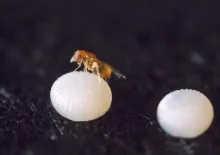Trichogramma pretiosum
Summary
| Type |
organism
|
|---|---|
| Genus |
Trichogramma
|
| Species |
pretiosum
|
| Common Name |
Parasitic wasp
|
| Description | |
| Publication |
|
| Organism Image | |
| Image Credit |
Trichogramma kaykai. Duotone Wageningen, The Netherlands. View Source. View Copyright
|
Assembly Stats
| Contig N50 |
78771
|
|---|---|
| GC Content |
38.10
|
| Scaffold N50 |
3706225
|
Other Information
| Community Contact |
Amelia Lindsey, University of California Riverside
|
|---|---|
| Links |
Analyses
| Name | Program |
|---|---|
| Whole genome assembly of Trichogramma pretiosum | Baylor College of Medicine genome assembly pipeline |
| BCM annotation of the Trichogramma pretiosum assembly using Maker and additional analyses | MAKER |
| Functional annotation of Trichogramma pretiosum BCM version 0.5.3 | AgBase functional annotation pipeline |
| Trichogramma pretiosum genome assembly Tpre_2.0 (GCF_000599845.2) | AllPaths v. 44620; Atlas Link v. 1.0; Atlas GapFill v. 2.2; redundans v. 0.12c |
| NCBI Trichogramma pretiosum Annotation Release 101 | NCBI Eukaryotic Genome Annotation Pipeline |
| Functional annotation of NCBI Trichogramma pretiosum Annotation Release 101 | AgBase functional annotation pipeline |
 An official website of the United States government.
An official website of the United States government.

Trichogramma pretiosum is a tiny egg parasitoid that is released by the millions as a biological control agent in Central and South America and to a lesser extent in North America and Asia. It is under consideration for the control of Tomato pests in Europe. It occurs naturally in North and South America. It has become established in Australia and on islands in the Pacific.
Several other Trichogramma species are also used in biological control and these are closely related to T. pretiosum. T. pretiosum has a short lifecyle of 11 days at 25 degrees Celsius and can be maintained on the eggs of the grainmoth Ephesia kuehniella.
Eggs of this moth species can be acquired through commercial suppliers. Because of their small size many different cultures can be maintained in a small space, we maintain our Trichogramma cultures in glass vials of 10cm*1.5cm.
In addition to its importance in biological control of lepidopteran pests, it is also very interesting because some populations are completely asexual because of an infection with parthenogenesis-inducing Wolbachia. The age of these completely infected populations varies and their prolonged asexual reproduction has led to a decay in traits involved in sexual reproduction. For instance, in the asexual populations from Peru, females have lost the ability to fertilize their eggs, while males, when produced by antibiotic treatment, still are sexually functional. In some Hawaiian populations of this species, males that are produced by antibiotic treatment appear to be completely sterile.
Having a genome of a sexual form of this species sequenced will allow us to determine the genes that are affected when a population becomes completely asexual, by later comparing the genome of asexual forms to that of the sexual form.
Data were generated by the Baylor College of Medicine's i5k pilot project.
View the Baylor College of Medicine's data sharing policy.
Genome update. Previously, the i5k Workspace@NAL hosted Whole genome assembly of Trichogramma pretiosum, BCM annotation of the Trichogramma pretiosum assembly using Maker and additional analyses, and Functional annotation of Trichogramma pretiosum BCM version 0.5.3. The assembly and annotations have updated to the most recent assembly, Trichogramma pretiosum genome assembly Tpre_2.0 (GCF_000599845.2) (https://www.ncbi.nlm.nih.gov/datasets/genome/GCF_000599845.2/), NCBI Trichogramma pretiosum Annotation Release 101 (https://www.ncbi.nlm.nih.gov/genome/annotation_euk/Trichogramma_pretiosum/101/), and Functional annotation of NCBI Trichogramma pretiosum Annotation Release 101 (https://i5k.nal.usda.gov/data/Arthropoda/tripre-%28Trichogramma_pretiosum%29/Tpre_2.0/2.Official%20or%20Primary%20Gene%20Set/).